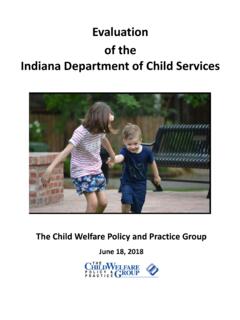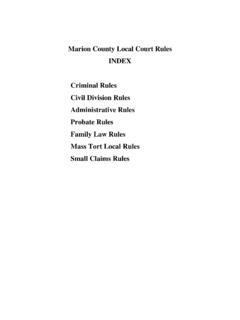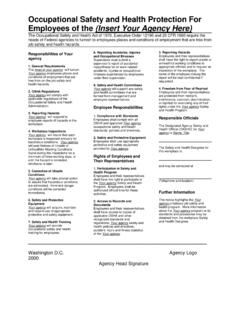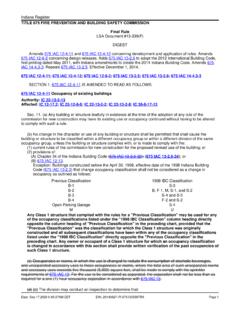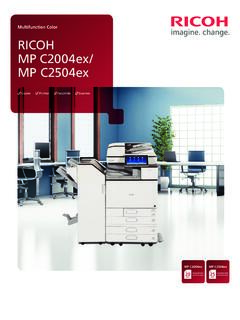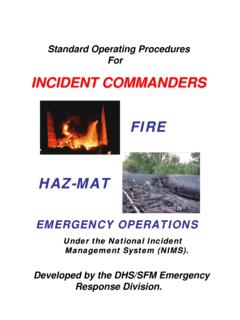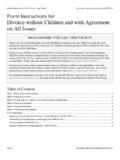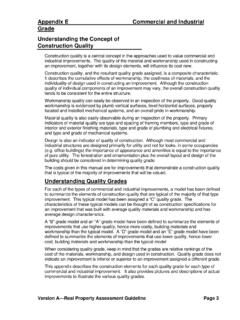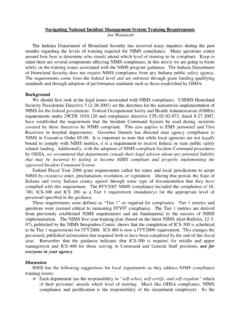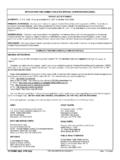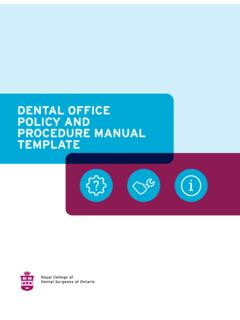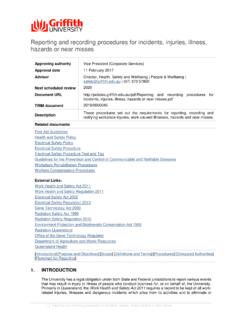Transcription of Indiana Family and Social Services Administration ...
1 Indiana ICES Program Policy Manual DFR. CHAPTER: 2600 SECTION: RESOURCES TABLE OF CONTENTS. RESOURCES. PRINCIPLES OF RESOURCES. DEFINITION OF RESOURCES. OWNERSHIP OF RESOURCES. Joint Ownership of Resources Joint Ownership of Vehicles AVAILABILITY OF RESOURCES. Insignificant Resources (S). RESOURCE ELIGIBILITY DATES. Resource Eligibility Date (S). Resource Eligibility Date (C). DETERMINING RESOURCE VALUE. Vehicle Valuations Real Property Value Life Estate/Remainder Value Life Estate/Remainder Tables Mineral Rights Value CONVERSION OF RESOURCES. VERIFICATION OF RESOURCES. MONITORING OF RESOURCES. RESOURCE LIMITS. TYPES AND VALUE OF PERSONAL PROPERTY RESOURCES. CASH. BANK AND OTHER ACCOUNTS. Savings and Checking Accounts Business Accounts (S). Time Deposits Safety Deposit Box Commingled Funds (S). College Savings Accounts Coverdell Educational Accounts ABLE Accounts RETIREMENT ACCOUNTS.
2 Retirement Accounts (S). Retirement Accounts (C). BURIAL RELATED RESOURCES. Funeral Planning Programs (S). Prepaid Funeral Agreements (S). Funeral Trusts Burial Plots (S). Burial Plots (C). INSURANCE. Life Insurance Life Insurance (S). Life Insurance (C). Casualty Insurance (C). HOUSEHOLD GOODS AND PERSONAL EFFECTS. INCOME PRODUCING PERSONAL PROPERTY. Income Producing Personal Property (S). Income Producing Personal Property (C). PERSONAL PROPERTY USED TO PRODUCE FOOD (C). STOCKS, BONDS, AND MUTUAL FUND SHARES. MORTGAGES, LOANS, AND PROMISSORY NOTES. LAND SALES CONTRACT. Land Sales Contract (S). Land Sales Contract (C). VEHICLES. Definition of Vehicle Exempt Vehicles (S). Non-Exempt Vehicles (S). Unlicensed Vehicles (S). Treatment of Vehicles (C). Recreational Vehicles and Equipment NON-RECURRING LUMP SUM PAYMENTS. Lump Sum Payments TRUST FUNDS. Trust Funds (S).
3 Trust Funds (C). LEGAL GUARDIANSHIP/REPRESENTATIVE PAYEE (C). Guardianship Accounts (S). RETROACTIVE PAYMENTS (S). PRORATED INCOME. TYPES AND VALUE OF REAL PROPERTY RESOURCES. REAL PROPERTY OWNERSHIP. VERIFICATION OF REAL PROPERTY OWNERSHIP. EXEMPT REAL PROPERTY RESOURCES. The Home Temporarily Unoccupied Home Home Replacement (C). Income Producing Real Property (S). TREATMENT OF NON-EXEMPT REAL PROPERTY. Counting Nonexempt Real Property (S). Exemption of Real Property (C). Property Not Marketed Within 30 Days (C). Overpayment Calculation after Property Sale (C). Property Unsold After Six Months (C). PLAN FOR ACHIEVING SELF-SUPPORT (S). HEALTH SAVINGS ACCOUNTS. RESOURCES EXEMPTED UNDER FEDERAL LAW. BENEFITS UNDER FEDERAL NUTRITION PROGRAM. WIC Benefits Older Americans Act (C). Child Nutrition Act (C). National School Lunch Act (C). SNAP BENEFITS/Commodities HUD ASSISTANCE.
4 RELOCATION ASSISTANCE ACT PAYMENTS. HOME ENERGY ASSISTANCE PAYMENTS. ASSISTANCE FOR CERTAIN INDIAN TRIBES/ALASKAN. NATIVES. compensation TO JAPANESE/ALEUTS. GERMAN REPARATION PAYMENTS (S). DOMESTIC VOLUNTEER SERVICE ACT compensation . PAYMENTS TO STUDENTS. YOUTH PROJECT PAYMENTS (S). DISASTER ASSISTANCE PAYMENTS. RADIATION EXPOSURE ACT BENEFITS. AGENT ORANGE SETTLEMENT ACT PAYMENTS. RESOURCES EXEMPTED BY TANF/SSI (S). PROPERTY SUBJECT TO LIEN (S). PROPERTY NECESSARY TO VEHICLE MAINTENANCE (S). FEDERAL TAX REFUND PAYMENTS. Earned Income Tax Credit (EITC) Payments (C. INCOME/RESOURCES/CONTRIBUTIONS OF SSI. RECIPIENT (C). INDIVIDUAL DEVELOPMENT ACCOUNT. RESOURCE ELIGIBILITY DETERMINATION. RESOURCES OF AG MEMBERS (S). Resource Eligibility Determination for Aliens Resource Deemed From Alien's Sponsor/Spouse Individual Sponsor Liability (C). Amount Deemed From Sponsor to Alien TRANSFERS OF PROPERTY (S).)
5 PROPERTY TRANSFERS AFFECTING ELIGIBILITY (S). Determining the Period for Disqualification (S). Transfers Not Affecting Eligibility (S). FOOTNOTES FOR CHAPTER 2600. Indiana ICES Program Policy Manual DFR. Chapter: 2600 Section: Resources Resources RESOURCES. This chapter presents requirements for determining eligibility based on resources. The chapter contains the following main sections: Principles of Resources (Section 2605);. Resource Limits (Section 2610);. Types and Value of Personal Property Resources (Section 2615);. Types and Value of Real Property Resources (Section 2620);. Plan for Achieving Self-Support (Section 2625);. Resources Exempted Under Federal Law (Section 2630);. Resource Eligibility Determination (Section 2635);. Transfer of Property (Section 2640); and Footnotes for Chapter 2600 (Section 2699). PRINCIPLES OF RESOURCES. The resources owned by specific individuals must be identified and evaluated according to the requirements of each program.
6 A distinction between resources and income must always be made so that proper consideration is given to each. Section 2605 outlines principles which apply to the consideration of resources in the determination of eligibility for assistance. All property not specifically exempted in the following sections are countable as a resource or, in the case of real property, may be required to be offered for sale or rent, according to the requirements of the particular program. DEFINITION OF RESOURCES. Resources are real or personal property that is owned solely or jointly by an individual. Real property is land, including buildings or immovable objects attached permanently to the land. Real property also includes life estates, remainder interests, and mineral rights. (Refer to Sections and ). Personal property includes all property that is not real property.
7 The eligibility system resource screens identify the following types of personal property as liquid resources: - cash on hand (including balances on a pay card);. - checking accounts;. - savings accounts, including Christmas Club;. - savings certificates;. - trust funds;. - individual retirement accounts;. - Keogh plans;. - credit union accounts;. - prepaid funeral agreements;. - stocks;. - bonds;. - nursing home accounts. OWNERSHIP OF RESOURCES. The owner of a resource is any individual who has the ability to liquidate or dispose of the resource. A. resource can be solely or jointly owned. Joint Ownership of Resources Joint ownership of resources, consisting of real or personal property, exists when the right to liquidate or dispose of the property is shared by more than one individual. When the resource is jointly owned by a married couple, one half (1/2) of the resource is to be attributed to each spouse; otherwise, the percentage of ownership is to be assigned as described below.
8 When any type of account held in a financial institution is jointly owned, the caseworker is to presume that all of the funds belong to each owner. The individuals are to be advised of this presumption and given the opportunity to rebut it. If an applicant/recipient rebuts, he is responsible for providing proof of ownership of the funds, which includes a record of deposits and withdrawals from the account. Following a successful rebuttal, the funds must be separated and placed in separate accounts. Only the funds actually belonging to the applicant/recipient will then be counted as a resource to him. This procedure applies whether or not the joint owners are all applying for or receiving assistance. If the funds are not separated, the balance is counted in its entirety by each joint owner. In addition to bank accounts, other real and personal property may be jointly owned.
9 If an applicant/recipient owns real property or non-liquid personal property with another applicant/recipient of any assistance program the eligibility system ERRP is to be completed for each owner. Then proportionate shares of the property are to be assigned to the joint owners in the eligibility system. The percentage amount of the share owned by each individual is counted as a resource. Refer to Section regarding the availability determination for jointly-owned vehicles. When a non-recipient is one of the joint owners of real or personal property, the availability of the applicant's/recipient's proportionate share must be determined. If the individual has the unrestricted right, authority or legal ability to liquidate or dispose of the property or his share of it, his proportionate share is available to him. If the joint owners do not have unrestricted rights to sell their interest in real property according to the title or other legal document, statements must be obtained from all joint owners to determine if they are all willing to sell the property.
10 If all joint owners are willing to sell, then the property will be considered available. Joint Ownership of Vehicles This section addresses the determination of "availability". of jointly owned vehicles. A jointly owned vehicle is considered an available resource to the Assistance Group (AG) when: It is jointly owned with another, (one or more). applicant/recipient who may or may not be in the same AG, or living at the same address;. It is jointly owned with a non-recipient who lives with the AG and either owner has physical possession and/or use of the vehicle and the non- recipient owner agrees to sell the vehicle;. It is jointly owned with a non-recipient who does not reside with the AG but the AG has physical possession or use of the vehicle and the non- recipient owner agrees to sell the vehicle;. It is jointly owned with a non-recipient who does not live with the AG and the AG does not have physical possession or use of the vehicle but, the joint-owner is willing to sell the vehicle, thus enabling the client to obtain his share of the vehicle's value.
